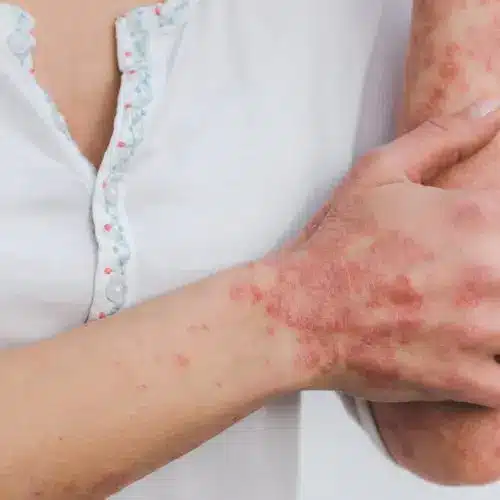
Psoriasis is a chronic inflammatory disease characterized by red scaly plaques on the skin. The most commonly affected areas are the scalp, elbows, and knees. Additional sites of involvement include the nails, hands, feet, and trunk. It affects about 2% of the world’s population and can develop at any age and in both sexes. Psoriasis incidence has a bimodal pattern, meaning it can show up during childhood or adulthood. The disease is commonly categorized as mild (covers less than 3% of the body), moderate (3%-10%), or severe (over 10%). It occurs most frequently in White individuals.
Psoriasis appears to be brought on by a combination of genetic and environmental factors. Certain individuals with genetic susceptibility develop the disease after exposure to environmental triggers such as infection, medications, and medical comorbidities, among others.
There are several variants of the disease, and variants can coexist in the same individual.
Variants Of Psoriasis
Chronic plaque psoriasis is most common, and disease burden can range from 1%-2% (mild disease) to greater than 90% (erythrodermic psoriasis) of the total body surface area (BSA). Typical findings include red scaly plaques that are often symmetric in distribution. The scalp, elbows, and knees are commonly involved. Lesions are often itchy and resolve with postinflammatory hyper- or hypopigmentation. When these plaques resolve they do not typically leave scars. Lesions can last from months to years in the same location.
Inverse psoriasis occurs in intertriginous areas of the body, such as the underarms, groin, genitals, and under the breasts.
When psoriasis involves areas of the face other than the hairline, eyebrows, and beard, it is usually an indication of more severe disease. Seborrheic dermatitis can coexist with psoriasis on the face and scalp (sometimes referred to as “sebopsoriasis”).
Other variants include:
- Psoriatic arthritis – Up to 50% of psoriasis patients may have psoriatic arthritis. Psoriatic arthritis is more common among individuals that have the disease in their nail and scalp. Rarely, psoriatic arthritis has been reported to develop prior to the skin findings of the condition.
- Guttate – An acute generalized eruption of small, well-defined, raindrop-like pink bumps with fine scale. This may occur 2-3 weeks after an upper respiratory infection and is most common in children.
- Erythrodermic – An uncommon but potentially life-threatening acute complication of psoriasis wherein large red patches with flaky skin cover most of the body surface.
- Pustular – An uncommon, sometimes severe, variant characterized by widespread pustules (whiteheads).
- Acrodermatitis continua of Hallopeau – An uncommon variant of pustular psoriasis affecting the hands and feet.
- Inverse – Occurs in intertriginous areas of the body, such as the underarms, groin, genitals, and under the breasts. The plaques of this disease are red and well-defined but often lack the classic scale as these body sites are generally moist.
- Nail – The nails of individuals with the condition can show several features. The most common are pitting (tiny indentations in the nails), distal onycholysis (lifting up at the edge of the nail), and splinter hemorrhages (red dots or lines). Individuals with the condition in their nails are at an increased risk of developing psoriatic arthritis.
Pregnant and immunocompromised patient considerations
- Approximately 50% of women report improvement of disease burden during pregnancy.
- Pustular psoriasis developing in hypocalcemic (low calcium) women during pregnancy is known as impetigo herpetiformis.
- HIV infection may precipitate or exacerbate this condition.
Reference:
VisualDx, Contributors: Jeffrey M. Cohen MD, Noah Craft MD, PhD, Belinda Tan MD, PhD, Catherine J. Wang, Susan Burgin MD
https://www.visualdx.com/visualdx/diagnosis/psoriasis?moduleId=101&diagnosisId=52228
About Dr. Innes
Dr. Innes is a board-certified dermatologist in Layton, Utah. If you feel you have sun damage and would like a skin check, call 801-773-4865 or schedule online by going to tannerclinic.com/appointments. You can learn more at https://tannerclinic.com/dermatology or on social media (Follow @thefrugalderm on Facebook, Instagram, and Youtube).Itthe

